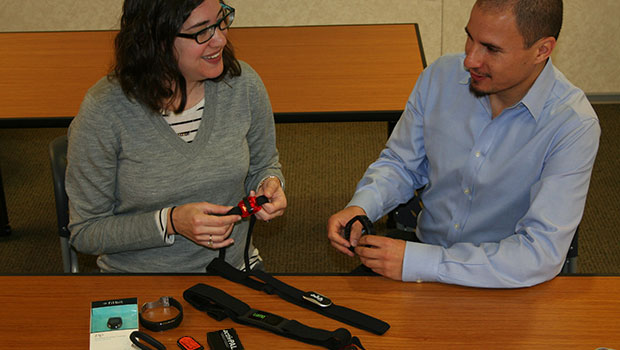Heart(rate) on your sleeve: Activity trackers aid health research

GHRI’s Dr. Dori Rosenberg and Research Specialist Camilo Estrada
The Jawbone UP, Nike FuelBand, Garmin Vivofit, and other wearable activity monitors have leapt, crept, and stepped to the top of holiday gift guides. They're a fun way to track physical activity. For Dr. Dori Rosenberg, a Group Health Research Institute assistant investigator, they're also a research tool. Dr. Rosenberg studies the link between daily activity and health. Her team is testing ways to make standing, walking, and moving easier for everyone—especially people who find exercise challenging because of age or chronic conditions.
"We're testing common activity trackers like the Fitbit to see if the devices help people reduce the time they spend sitting or lying down," says Dr. Rosenberg. Trackers work only if people wear and check them, though, so she and her team asked focus groups with people of different ages and health status what they want in an activity monitor.
Comfort, accuracy, and ease of use are high on the list. Some users prefer devices powered by watch batteries that don't need charging. Some want a versatile design so the device can be in a pocket, clipped to clothes, or on the wrist. Many people, especially older participants, want to get information about their movement, steps, and calories directly from the device screen or through a website instead of a smartphone interface.
Activity trackers have come a long way from old-school pedometers that mechanically measure steps. Most activity monitors on the market are accelerometers that electronically detect vertical or horizontal motion. These devices record sedentary behavior such as sitting or sleeping as an absence of motion. They don't detect standing, although some monitor location, heat, sweat, or heart rate. Dr. Rosenberg sometimes uses a more sophisticated tracker called an “inclinometer” in her studies that also measures tilt. This device, which is mainly used for research, can detect if the wearer is sitting, standing, or lying down. It counts breaks from sitting, which is useful because of a potential link between sitting and poorer health.
Dr. Rosenberg is conducting several studies that use activity monitors, from research-only devices to the widely available Fitbit Zip. Here are two of the studies:
- A pilot project with Group Health orthopedic surgeon Sean Adelman, MD, will use fitness trackers to see how shoulder, hip, or knee surgery changes daily activity and whether the amount of activity affects recovery. The study, which begins in 2015, is supported by the Group Health Partnership for Innovation.
- The PAST project studies activity in men getting treatment for prostate cancer. Men on androgen deprivation therapy can lose bone and muscle mass, and exercise might counteract that effect. Right now, the researchers and two patient advisors are using a combination of popular activity trackers and research-grade devices to test accuracy and usability. Later, the team plans to study whether wearable trackers increase activity and improve quality of life. Support comes from the National Cancer Institute.
Dr. Rosenberg and her team need to understand the devices themselves so they can answer study participants’ questions, troubleshoot problems, and help participants use them correctly. They don't want to waste time asking participants to use devices that are uncomfortable or hard to figure out.
“We're looking for usability, accuracy, and potential difficulties," Dr. Rosenberg says. The research team—including GHRI analyst DT Tran and postdoctoral researcher Salene Jones, PhD, and VA Puget Sound Health Care System postdoctoral fellow Erin Bouldin, PhD—is trying out different devices before handing them over to study participants. Project manager Anne Renz, MPH, says, "I've done mini-experiments, wearing several devices in different combinations to compare them.”
The real test, however, comes when patients report on how the activity trackers change their routines and the researchers see if the technology enhanced their health. Speaking for the team, Ms. Tran said, "We're excited to hear what the study participants tell us about what they prefer and what motivates them to be active."
by Chris Tachibana


